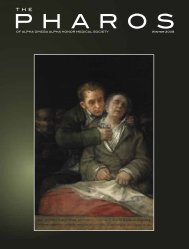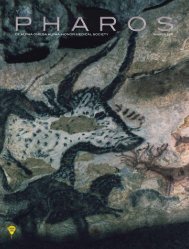Download Selections from The Pharos Autumn 2004 Edition
Download Selections from The Pharos Autumn 2004 Edition
Download Selections from The Pharos Autumn 2004 Edition
- No tags were found...
You also want an ePaper? Increase the reach of your titles
YUMPU automatically turns print PDFs into web optimized ePapers that Google loves.
What do we mean by “the art of medicine”?to “fix” the human body <strong>from</strong> trades such as auto repair. 8 Asthe themes presented above assert, even when technical dexterityfails to “fix” the patient’s disease, the caregiver’s professionalduty has not ended.It is nevertheless possible that, in our time, to define “theart of medicine” in strict terms would undercut its very nature.Its application in clinical practice is neither constant nor consistent.It is no secret that, in medicine, as we move <strong>from</strong> onehospital bed to the next, we encounter remarkably differentpatients. Even among patients with clinical findings so similarthey could be considered equivalent in any given clinical study,we discover vastly dissimilar personal situations. As caregivers,we quickly learn to adapt our approaches to each patient:how we listen, how we position ourselves in the room, howloudly we speak, whether we hold the patient’s hand or not.We understand that one will tolerate a drug, while the nextpatient, clinically indistinguishable, may not.Somewhere in this realm of patient care exists an indefinablebut very real part of what it means to practice medicine.This is the art of medicine, as we caregivers have definedit ourselves. <strong>The</strong> art consists neither of optimal physicianpatientcommunication nor the appreciation of a patient’s trueindividuality. It is neither listening to patients nor empathizingwith them. <strong>The</strong> art of medicine is comprised of all of thesetogether, and much more.Although its meaning may only be approximated, this ellipticalterm defines who we are and what we do as caregivers.We seem unable to part with the methodological link betweenmedicine and art. We cannot speak of the art without shapinghow we see ourselves in the long shadow of our discipline’shistory. When we do, we may be surprised at how much (orhow little) we have changed our art since the isle of Cos.AcknowledgementI am grateful to Marcia Day Childress, Ph.D., of the University ofVirginia Health Sciences Center Program of Humanities in Medicinefor her generous input.References1. Groopman J. Hurting all over: <strong>The</strong> pain is real, but is thedisease? New Yorker 2000 Nov 13: 78–92.2. Fye WB. President’s page: Convocation address: <strong>The</strong> art ofmedicine. J Am Coll Cardiol 2002; 39: 1238–41.3. Meyers JI. <strong>The</strong> perspective of a plaintiff’s attorney in dissemblingthe art of medicine as it relates to the interpretation andmanagement of cervical smears. Am J Clin Pathol 2001; 116 (Supplement1): S116–S122.4. Greco FA. What is the art of medicine? Am J Med 1985; 79:279.5. Hilliard IM. <strong>The</strong> art of medicine. Part I: Balancing scientificskills with good communications. Canad Med Assoc J 1978; 119:1230–32.6. Jouanna J. <strong>The</strong> Birth of Western Medical Art. In: GrmekMD, editor. Western Medical Thought <strong>from</strong> Antiquity to the MiddleAges. Shugaar A, translator. Cambridge (MA): Harvard UniversityPress; 1998: 22–71.7. Phillips ED. Aspects of Greek Medicine. New York: St.Martin’s Press; 1973.8. Kass LR. Toward a More Natural Science: Biology and HumanAffairs. New York: Free Press; 1985.9. Pellegrino ED, Thomasma DC. <strong>The</strong> Virtues in Medical Practice.New York: Oxford University Press; 1993.10. Hinohara S, Niki H. Osler’s “A Way of Life” and Other Addresses,with Commentary and Annotations. Sir William Osler.Durham (NC): Duke University Press; 2001.11. Peabody FW. <strong>The</strong> care of the patient. JAMA 1927; 877–82.12. Inui TS. Establishing the doctor-patient relationship: science,art, or competence? Schweiz Med Wochensher 1998: 128: 225–30.13. García-Campayo J, Aseguinolaza L, Lasa Labaca G. Empatía:la quintaesencia del arte de la medicina. Medicina Clínica (Barc)1995; 105: 27–30.14. Charon R, Williams P. Introduction: <strong>The</strong> humanities andmedical education. Acad Med 1995; 70: 758–60.15. Skenderis BS II, Rustum YM, Petrelli NJ. Basic science researchin postgraduate surgical training: Difficulties encountered byclinical scientists. J Cancer Educ 1997; 12: 245–48.16. Satakiff RT, Evaluation of professional singers. OtolaryngolClin North Am 2000 33: 923–56.17. McAlister FA, Graham I, Karr GW, Laupacis A. Evidencebasedmedicine and the practicing clinician. J Gen Int Med 1999;14: 236–42.18. Elliot WJ. An individualized approach to the hypertensivepatient with renal disease: Six illustrative case studies. J Clin Pharmacol1995; 35: 98–102.19. Spiro H. What is empathy and can it be taught? Ann Int Med1992; 116: 843–46.<strong>The</strong> author’s address is:University of Virginia Health Sciences CenterMain HospitalP. O. Box 800696Charlottesville, Virginia 22908-6906E-mail: jhg2d@virginia.eduARE YOU MOVING?Help the society and make sure that you continue toreceive <strong>The</strong> <strong>Pharos</strong> by reporting your new and oldaddress, name of school, and year of election, toAlpha Omega Alpha525 Middlefield road, Suite 130Menlo Park, California 94025-3441Please include the address printed on your most recent issueof <strong>The</strong> <strong>Pharos</strong> when requesting any change.30 <strong>The</strong> <strong>Pharos</strong>/<strong>Autumn</strong> <strong>2004</strong>














